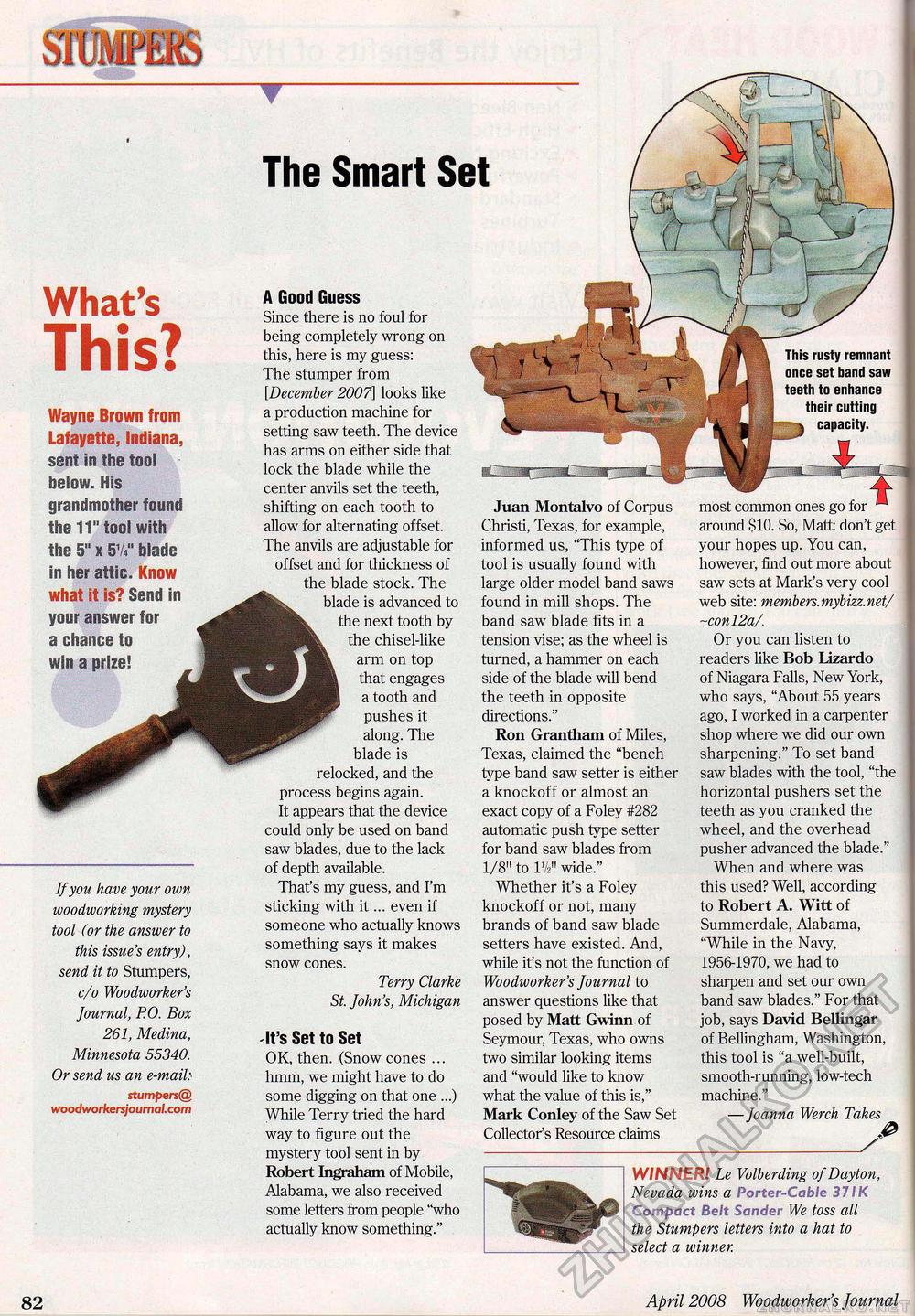Woodworker's Journal 2008-32-2, страница 80
A Good Guess Since there is no foul for being completely wrong on this, here is my guess: The stumper from [December 2007] looks like a production machine for setting saw teeth. The device has arms on either side that lock the blade while the center anvils set the teeth, shifting on each tooth to allow for alternating offset. The anvils are adjustable for offset and for thickness of the blade stock. The blade is advanced to the next tooth by the chisel-like arm on top that engages a tooth and pushes it along. The blade is relocked, and the process begins again. It appears that the device could only be used on band saw blades, due to the lack of depth available. That's my guess, and I'm sticking with it... even if someone who actually knows something says it makes snow cones. Terry Clarke St. John's, Michigan It's Set to Set OK, then. (Snow cones ... hmm, we might have to do some digging on that one ...) While Terry tried the hard way to figure out the mystery tool sent in by Robert Ingraham of Mobile, Alabama, we also received some letters from people "who actually know something." What's This? Wayne Brown from Lafayette, Indiana, sent in the tool helm. His grandmother found the 11" tool with the 5" x 5'«" blade in her attic. Know what it is? Send in pur answer for a chance to If you have your own woodworking mystery tool (or the answer to this issue's entry), send it to Stumpers, c/o Woodworker's Journal, P.O. Box 261, Medina, Minnesota 55340. Or send us an e-mail: stumpers@ woodworkersjournal.com The Smart Set WINNER! Le Volberding of Dayton, Nevada wins a Porter-Cable 37IK Compact Belt Sander We toss all the Stumpers letters into a hat to select a winner. most common ones go for around $10. So, Matt: don't get your hopes up. You can, however, find out more about saw sets at Mark's very cool web site: members.mybizz.net/ ~conl2a/. Or you can listen to readers like Bob Iizardo of Niagara Falls, New York, who says, "About 55 years ago, I worked in a carpenter shop where we did our own sharpening." To set band saw blades with the tool, "the horizontal pushers set the teeth as you cranked the wheel, and the overhead pusher advanced the blade." When and where was this used? Well, according to Robert A. Witt of Summerdale, Alabama, "While in the Navy, 1956-1970, we had to sharpen and set our own band saw blades." For that job, says David Bellingar of Bellingham, Washington, this tool is "a well-built, smooth-running, low-tech machine." —Joanna Werch Takes _/ Juan Montalvo of Corpus Christi, Texas, for example, informed us, "This type of tool is usually found with large older model band saws found in mill shops. The band saw blade fits in a tension vise; as the wheel is turned, a hammer on each side of the blade will bend the teeth in opposite directions." Ron Grantham of Miles, Texas, claimed the "bench type band saw setter is either a knockoff or almost an exact copy of a Foley #282 automatic push type setter for band saw blades from 1/8" to 1V2" wide." Whether it's a Foley knockoff or not, many brands of band saw blade setters have existed. And, while it's not the function of Woodworker's Journal to answer questions like that posed by Matt Gwinn of Seymour, Texas, who owns two similar looking items and "would like to know what the value of this is," Mark Conley of the Saw Set Collector's Resource claims This rusty remnant once set band saw teeth to enhance their cutting capacity. 82 April 2008 Woodworker's Journal |








